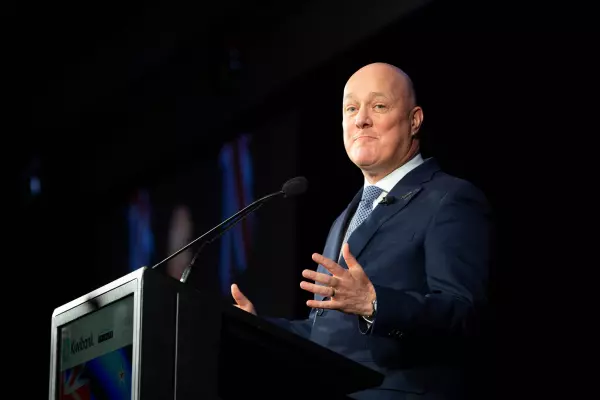Tomorrow morning you wake up and read in the newspaper that you are now the new minister of health.
Bugger! Why couldn’t it have been something cushy like tourism, horse racing or the minister for ‘The Lord of the Rings’, which we had in 2001. Anything but the health graveyard portfolio!
After the initial shock and three double-shot coffees, it's time to decide what you’re going to do.
Let's ask ChatGPT for ‘A plan to fix New Zealand health’.
The answer: “To increase funding, improve primary care, address workforce shortages, focus on preventative care, invest in technology, increase patient involvement." But hold on, isn't this the same waffle the consultants got paid $100 million-plus for, only better?
Regurgitating the sound-bite bollocks of "health system constipation" and "postcode healthcare", or blaming covid, could buy time.
However, pretty soon you'll cop it from the doctors, nurses, the other side of parliament, media drongos and the mother-in-law for her bunions.
The whole system is quickly descending to hell in a handbasket and every day the news gets worse. So, there's no time to park the problem in a think tank or expert review panel.
There's no time to grow the health workforce, either. It takes 11 years to fully train a general practitioner and five years for a registered nurse.
By then, I will be fired and sitting with the numpties on the back benches.
What's the answer?
Surely someone – somewhere – has solved this problem before. Fortunately, the answer is yes.
Surprisingly, the standout solution is right in our backyard – Canterbury's outstanding response to the post-2011 earthquake health crisis.
That event caused a serious loss in health system capacity. We lost 106 hospital beds, five GP practices, 19 pharmacies and 635 care home beds. Eleven clinicians passed away.
Compounding the situation, Canterbury already had unrelenting growth in healthcare demand and pre-earthquake projections were that, by 2020, it would need an added 450 acute hospital beds, 20% more general practitioners, 2,000 more aged residential care beds and another 8,000 people in the health workforce to deal with an ageing population.
So, what did it do?
It pivoted to a highly integrated primary care and hospital model with guidelines that enabled as many decisions as possible to be made immediately and cheaply by providers in the community.
Essential devolution of decision-making to the healthcare coalface is beautifully described by the "principle of subsidiarity", meaning “a central authority should have a subsidiary function, performing ONLY those tasks which cannot be performed at a more local level”.
It's a concept well understood by successful business leaders and less so by autocratically inclined government officials.
Essentially, it's the polar opposite of our current NZ health reforms.
Canterbury Health’s 2011-12 pivot was pure subsidiarity! It shifted to a highly integrated primary care-hospital model with guidelines so that as many decisions as possible could be made more immediately and cheaply by providers in the community.
It was pretty much the antithesis of the Wellington-centric decision-making model at the heart of the current reforms.
The Canterbury turnaround, as reported in The Kings Fund 2017 paper, was impressive.
Emergency department attendance rates fell (from 14.7 to 12.7 per 1,000 people), hospital admission rates fell (from 6.59 to 5.83 per 1,000 people), pathology costs were down 12%, radiology down 18%, pharmacy down 1%, and more.
Many other independent reports and reviews have been written on Canterbury and all are glowing. Indeed disappointingly, there was an attempt by detractors to suppress some reports because they ran counter to their negative Canterbury narrative.
Dirty politics
I won’t rehash the embarrassing shenanigans and "dirty politics" that went on as they have been well covered by Ian Powell in three 2021 articles (A very bureaucratic coup Part One and Two and Reputations in tatters) and the investigative pieces by Newsroom's David Williams.
My only comment is that this decade-long saga was a national embarrassment that went on far too long.
Now, the Canterbury subsidiarity model clearly works and would be an excellent starting point.
It has a significant following with about 40 health organisations, Australia (30), NZ (13) and the UK (6) registered on the HealthPathways Community website.
This devolved approach has much in common with the direction being taken by US Medicare Advantage in the US, the regionalising of the NHS in the UK, Ontario in Canada and other parts of the world.
The elephantine obstacle we now have is the highly centralised model the health reforms have, with everything decided out of Wellington, (a bit like the Russian army).
What the Canterbury model needs is decision-making devolved to frontline doctors and nurses (Ukrainian-like).
So, I believe NZ’s only option is a hard U-turn.
Park the current health reforms and double down on subsidiarity healthcare.
An unfortunate complication is that, seven months ago, Andrew Little scrapped DHBs and sidelined Primary Health Organisations (PHOs) and these are the very organisations needed to roll out devolved healthcare.
Fortunately, the likely model for localities will probably be identical to the original guidelines for PHO’s. So, we can simply rename the PHOs as localities (saving three years of prototyping, consulting fees and reams of paper) and claim victory.
The disappearance of DHBs is more problematic.
Hospital clinical leadership is still intact but other leadership roles, such as change management and local strategy have gone.
What's more, clinical leaders today aren’t sitting around doing Wordle or Sudoku. They're frantically busy.
Freeing up their time for such a major programme of work will be a challenge, but hopefully solvable.
I say again, subsidiarity healthcare is proven to work and if it is aggressively rolled out across the country, it's the step change needed to turn NZ healthcare around and avoid an ongoing spiralling decline.














